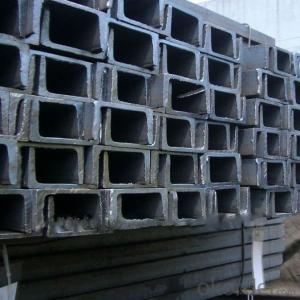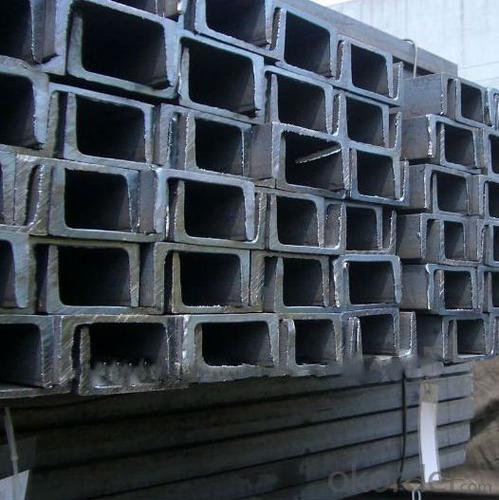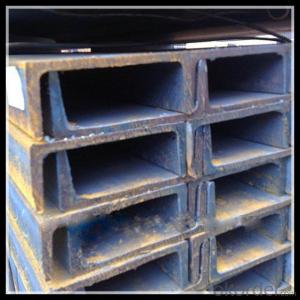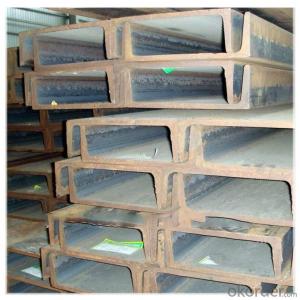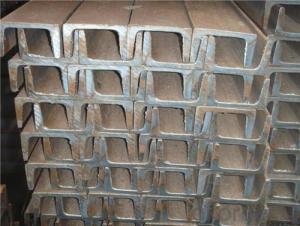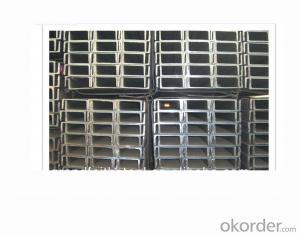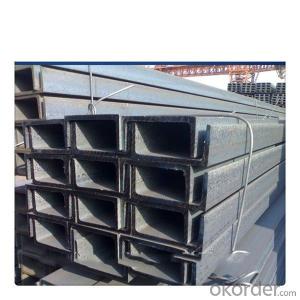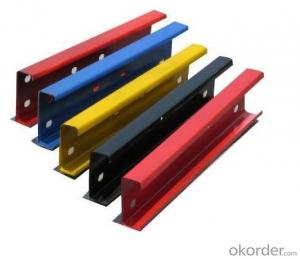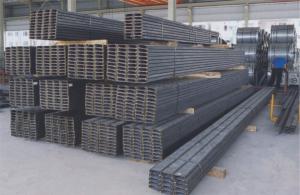Height 88mm the Thickness 8mm Surface and Length: according to the requirements of Channel Steel
- Loading Port:
- Qingdao
- Payment Terms:
- TT OR LC
- Min Order Qty:
- 10 m.t.
- Supply Capability:
- 100000 m.t./month
OKorder Service Pledge
OKorder Financial Service
You Might Also Like
Height 88mm the Thickness 8mm Surface and Length: according to the requirements of Channel Steel
U Channel Steel the Length Thickness According to the Customer
1、the details information of our Channel Steel
1)the ordinary model
Height: | 90-400mm |
Thickness: | 9-14.5mm |
Surface: | according to the customers’ requirements |
Length: | As customers’ requirements |
Size: | 90*37*4.5mm--400*104*14.5 mm . |
Punch: | Can be punched as customer's drawing |
Material: | Q195/Q235/ Q215/Q345/SS400/S235JR, A36,SS400,SS540 ASTM A36 and so on |
2)the light model
Height: | 90-400mm |
Thickness: | 6.4-8.0mm |
Surface: | Painted or Galvanized;according to the customers’ requirements |
Length: | As customers’ requirements |
Size: | 50*32*4.4mm--400*115*8.0mm . |
Punch: | Can be punched as customer's drawing |
Material: | Q195/Q235/ Q215/Q345/SS400/S235JR, A36,SS400,SS540 ASTM A36 and so on |
2、the Product Advantage
1) We can design the channel steel according to customers’requirements
2) We can manufacture under complete quality control system---ISO9001&SGS
3) We can installed with instruction of experienced engineers
4) Easy to assemble and dismantle
5) Eco-friendly material: can be used for several times and can be recycled
6) Shorter construction period, longer using time
7) High strength and stiffness, high weight bearing.
3、why choose us ?Product Advantage
1)The channel steel quality is prime quality
2)Our price is competitive price with our competitor
3)We provide the professional service
4)Prompt delivery & Seaworthy packing
5)Mill Test Certificate
Company Information
which is one of the largest manufacturing bases of Steel Channel in northern China. We are a company that is specialized in producing Stainless Steel Channel、Prime Stainless Steel Channels and so on.
With years of development, our company won the trust and excellent reputation of customers for the quality of our products and sincere service, as well as foreign users of the community.
Please contact me if you are interested in our products and I will try my best to offer you the best goods and service.
- Q: What are the different surface finishes available for steel channels?
- There are several different surface finishes available for steel channels, each offering unique benefits and applications. Some of the most common surface finishes include: 1. Hot-Dip Galvanized: This process involves dipping the steel channel into a bath of molten zinc, which creates a protective coating on the surface. Hot-dip galvanizing provides excellent corrosion resistance, making it ideal for outdoor applications or environments with high humidity or exposure to chemicals. 2. Powder Coating: Powder coating involves applying a dry powder to the steel channel's surface, which is then heated to form a durable, protective layer. This finish is available in a wide range of colors and provides excellent resistance to chipping, scratching, and fading. Powder coating is often used for decorative purposes or in applications where aesthetics are important. 3. Electroplating: Electroplating involves depositing a layer of metal, such as chrome or nickel, onto the steel channel's surface through an electrolytic process. This finish enhances the channel's appearance, provides corrosion resistance, and can also improve the channel's hardness or wear resistance, depending on the plated metal. 4. Painted: Steel channels can be painted using various types of coatings, such as epoxy, acrylic, or enamel. Painting provides both aesthetic appeal and protection against corrosion. Different types of paints can be chosen based on the desired level of durability, weather resistance, and color options. 5. Stainless Steel: Steel channels can also be manufactured from stainless steel, which inherently provides corrosion resistance. Stainless steel channels are commonly used in applications where hygiene, high temperatures, or exposure to aggressive chemicals are a concern. The choice of surface finish for steel channels depends on the specific requirements of the application, including the desired level of corrosion resistance, durability, aesthetics, and environmental factors. Consulting with a steel supplier or surface finishing expert can help determine the most suitable finish for a particular project.
- Q: How do steel channels contribute to the structural integrity of a building?
- Steel channels contribute to the structural integrity of a building in several ways. Firstly, they provide additional support and reinforcement to the structural framework, enhancing its overall strength and stability. Secondly, steel channels help distribute the load evenly across the building, reducing the risk of structural failure due to uneven weight distribution. Additionally, steel channels are resistant to bending and twisting forces, making them ideal for withstanding high-pressure and seismic activities. Overall, steel channels play a crucial role in improving the durability and safety of a building's structure.
- Q: Can steel channels be used in the construction of HVAC support structures?
- Yes, steel channels can be used in the construction of HVAC support structures. Steel channels provide excellent structural support and can be easily fabricated to the required dimensions. They offer high strength and durability, making them suitable for supporting HVAC equipment such as ductwork, pipes, and air handling units. Steel channels also have the advantage of being resistant to corrosion, which is beneficial in HVAC environments where moisture and condensation are common.
- Q: Channel 40 is used as a support leg. How many tons can each bear?
- Press the axle, the upper and lower are hinged support, channel steel 40a, Q235 steel, without vibration, calculated the carrying capacity is about: 163.69kN.
- Q: Can steel channels be used for window lintels?
- Yes, steel channels can be used for window lintels. Steel channels are strong and durable, making them suitable for supporting the weight of a window lintel. They provide structural support and help distribute the weight evenly, preventing any potential sagging or cracking. Additionally, steel channels can be customized to fit the specific dimensions required for the window lintel, ensuring a precise and secure fit. Overall, using steel channels for window lintels is a common and effective choice in construction and building projects.
- Q: Can steel channels be used for supporting rooftop equipment?
- Yes, steel channels can be used for supporting rooftop equipment. Steel channels provide a sturdy and reliable structural support system that can withstand the weight and load of rooftop equipment.
- Q: How do steel channels contribute to the overall durability of a railway bridge?
- Steel channels contribute to the overall durability of a railway bridge in several ways. Firstly, steel channels provide structural support and strength to the bridge, allowing it to withstand heavy loads and forces. The channels are typically designed to distribute the weight of the train evenly across the bridge, preventing any localized stress points that could lead to structural failure. Additionally, steel channels are highly resistant to corrosion and rust, which is crucial for a railway bridge exposed to various weather conditions and environmental factors. This corrosion resistance ensures that the bridge remains strong and durable over time, reducing the need for frequent maintenance and repairs. Another way steel channels contribute to durability is through their ability to absorb and dissipate energy. In the event of a sudden impact or excessive vibrations caused by passing trains, the steel channels can absorb and disperse the energy, minimizing the risk of damage or structural failure. Furthermore, steel channels are often used in the construction of railway bridges due to their fire-resistant properties. Steel has a high melting point, making it less prone to deformation or collapse in the event of a fire. This enhances the overall safety and durability of the bridge, as it can withstand extreme temperatures for an extended period. Overall, steel channels play a critical role in enhancing the durability of a railway bridge by providing structural strength, corrosion resistance, energy absorption, and fire-resistant properties. Their contribution ensures the longevity and safety of the bridge, allowing it to effectively support the transportation of trains and passengers for many years.
- Q: Can steel channels be used for machinery platforms?
- Yes, steel channels can be used for machinery platforms. Steel channels are often used in construction and industrial applications due to their strength and durability. They provide structural support and stability, making them suitable for supporting heavy machinery and equipment on platforms. Additionally, steel channels can be easily fabricated and customized to meet specific requirements, such as the size and load-bearing capacity needed for machinery platforms.
- Q: What are the limitations of using steel channels?
- There are several limitations associated with using steel channels in various applications. Firstly, one of the main limitations is cost. Steel channels can be relatively expensive compared to other materials such as wood or certain types of plastics. This higher cost can make it less feasible for certain projects or industries with strict budget constraints. Secondly, steel channels are generally quite heavy and bulky, which can make transportation and installation more challenging. The weight of steel can require additional labor and equipment, increasing overall project costs and potentially limiting its use in certain applications where weight is a critical factor. Another limitation is corrosion. Steel is prone to rusting and corrosion over time, especially in environments with high moisture or exposure to certain chemicals. This corrosion can weaken the structural integrity of the steel channel and may require regular maintenance or protective coatings to prevent or slow down the corrosion process. Additionally, steel channels have limitations in terms of design flexibility. Unlike other materials such as wood or plastic, steel channels are not easily shaped or molded into complex or intricate designs. This lack of design flexibility can limit their use in certain architectural or decorative applications where aesthetic considerations are important. Lastly, steel channels can conduct heat and electricity, which may not be desirable in certain applications. For example, in electrical systems or sensitive electronic equipment, steel channels may need to be insulated or replaced with non-conductive materials to prevent electrical hazards or interference. Overall, while steel channels are strong and durable, they do come with limitations in terms of cost, weight, corrosion, design flexibility, and electrical conductivity. These limitations need to be carefully considered when deciding on the suitability of steel channels for a particular project or application.
- Q: Can steel channels be used for window and door frames?
- Yes, steel channels can be used for window and door frames. Steel channels provide strength, durability, and stability, making them suitable for supporting the weight and ensuring the stability of window and door structures. They can also be customized to fit specific dimensions and shapes, making them a versatile choice for window and door frame construction.
Send your message to us
Height 88mm the Thickness 8mm Surface and Length: according to the requirements of Channel Steel
- Loading Port:
- Qingdao
- Payment Terms:
- TT OR LC
- Min Order Qty:
- 10 m.t.
- Supply Capability:
- 100000 m.t./month
OKorder Service Pledge
OKorder Financial Service
Similar products
Hot products
Hot Searches
Related keywords
